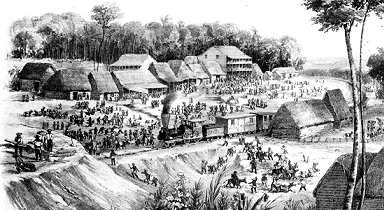Panama Railway
|
|
The Panama Railway or Panama Railroad was the world's first transcontinental railroad. It stretches across the isthmus of Panama from the Atlantic Ocean to the Pacific Ocean. The Panama Railway was built during the period of 1850 to 1855. The infrastructure of this functioning railroad was of vital importance to the plan to build the Panama Canal decades later.
The need for the railway was inspired by the California Gold Rush. The project was begun in 1850 and the railroad was completed in 1855, with the first train running from ocean to ocean on 28 January of that year.
| Contents |
Financing
The railway cost some $8 million US to build (8 times the initial estimate in 1850), and presented considerable engineering challenges, going over mountains and through swamps. Over 300 bridges and culverts needed to be built along the route.
It was largely built and financed by private companies from the United States. Among key individuals in building the railway were William H. Aspinwall, George Muirson Totten, and John Lloyd Stephens. Ownership of the railroad was originally by a publicly traded corporation based in New York City, which bought exclusive rights to build across the isthmus from the government of Colombia, Panama being a province of Colombia at the time. The stock of the Panama Railway Company quickly became some of the most highly valued of the era.
The railway carried significant traffic even while it was under construction, with traffic carried by mules over the unfinished sections. This had not been originally intended, but people crossing the isthmus to California were eager to use such track as had been laid. When only 7 miles (10 km) of track had been completed the railway was doing a brisk business, charging $25 per person for the train ride and another $10 to walk the remaining 40+ miles (60 km) of right-of-way across the isthmus. By the time the line was completed, more than one-third of its cost had already been paid for from fares.
Engineering and medical difficulties made the Panama Railway the most expensive railway (per unit length of track) built at the time. Some swamps were found to require fill over 100 feet (30 m) in depth before a solid bed could be constructed.
Death toll
It is estimated that more than 12,000 people may have died in construction of the railroad, though the Panama Railway company kept no official count. Cholera and malaria killed numerous workers. These railroad workers were from the United States, Europe, China, and also included some African slaves. Many of these workers had come to Panama to seek their fortune, and had arrived with little or no identification. Many died with no next of kin, nor permanent address, nor even a last name.
Cadaver trade
As disease - spread mainly by the mosquitos that thrived in Panama's swampy conditions - and exhaustion took their toll on the workers, the disposal of unidentifiable bodies was a boon to those with proper connections. Medical schools and teaching hospitals needed cadavers to train budding physicians, and paid handsomely for anonymous bodies pickled in barrels shipped up from the tropics. The Panama Railroad Company itself sold the corpses abroad, and the income generated was sufficient to maintain the Company's own hospital. A journalist reported sighting the chief doctor at the Panama Railroad Company's hospital conscientiously bleaching skeletons of dead workers, in hopes of compiling a skeletal museum of all the known races working on the railroad.
Completion
Upon completion, the 48 mile (77 km) long railway was proclaimed an engineering marvel of the era. The line was built as double track.
The Atlantic terminal is in Colón, Panama; the Pacific in Panama City.
Until the opening of the Panama Canal, it carried the heaviest volume of freight per unit length of any railroad in the world. The existence of the railway was key in the selection of Panama as the site of the canal. In 1881 the French Compagnie Universelle du Canal Interocéanique purchased controlling interest in the Panama Railway Company. In 1904 the United States government purchased the railway from the French canal company. At the time railway assets included some 75 miles (120 km) of track, 35 locomotives, 30 passenger cars, and 900 freight cars.
The construction and opening of the Panama Canal
The railway greatly assisted in the building of the canal, which closely paralleled and in some places took over the rail line. Parts of the rail route were moved during the building of the canal, and considerable additions were made to the rail system. The rebuilt and improved Panama Railway beside the canal was completed in 1912
Post Panama Canal
After World War II few additional improvements were made to the Panama Railway, and it declined in the late 20th century. In 1979 the US government handed over control to the government of Panama. On 19 June, 1998 the government of Panama turned over control to the private Panama Canal Railway Company ("PCRC"), with majority shares owned by the Kansas City Southern Railroad. In 2000 and 2001 a large project upgraded the railway to handle large shipping containers, to compete in cargo transport with the Panama Canal. The line is now single track.
Gauge
The Panama Railway was originally 5' 0" gauge, but when it was rebuilt in 2000, the gauge was changed to 4' 8½" so as to use off the shelf equipment.
See also
External links
- Welcome to the Panama Railroad (http://www.trainweb.org/panama/) on trainweb.org
- Panama Canal Railway Co. (http://www.kcsi.com/corporate/pcrc.html)
- Panama Railroad: Stock Certificates; an 1855 Newspaper Report of its Opening; 1861 & 1913 Maps; Early Harper's Engravings; and 1861 Schedule (http://cprr.org/Museum/Ephemera/Panama_Railroad_Stock_1868.html)

